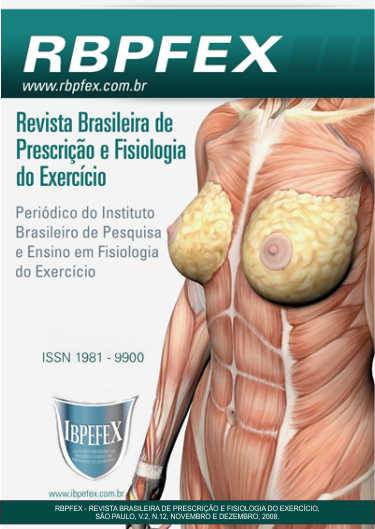Effects of a resistance training program with weight on the muscular strength
Abstract
The objective of this study was to verify the increase of muscular strength in the muscle chest in adult individuals of the masculine gender, with intermediate level of muscular activity practice. They were chosen 15 individuals, with medium age 23.73 ± 3.75 years old, without taking in consideration socioeconomic level, students of an academy, residents in Joinville/SC. They used the consent inform, after that they used the tests of 1 RM for the chest (Chest Press) and Resistance of Superior Members (superior portion of the body). After that measured the percentile of fat and the percentile of muscular mass. The applied planning elapsed initially with a base work, with duration of one week and intensity around 50 to 60% of the maximum load. In the second phase, the participants accomplished a training seeking, only, the increase of pure force. With duration of five weeks and intensity among 60 to 90% of the maximum load. According to the average of the results between pré and powder-test, the Test was used t to discover the statistical significância. The results obtained for %G 0.2115; %MM 0.878; 1RM 0.0139 and RMSS 0.0001. In summary, this training model was efficient in improving the muscular force (p <0.05), as well as it improved the level of the muscular resistance in the superior members in relation to the initial levels. Therefore, the systematic and specific practice of exercises also caused improvement in this aspect.
References
- Andersen, J.L.; Schjerling, P.; Saltin, B. Muscle, genes and athletic performance. Scientific American, September, 2000.
- Bacurau, R.F.; Navarro, F.; Rosa, L.F.B.P.; Uchida, M.C. Hipertrofia: hiperplasia: fisiologia, nutrição e treinamento. São Paulo: Phorte Editora, 2001.
- Bailey, D.A.; Shephard, R.J.; Mirwald, R.L. Validation of a self-administered home test of Cardio-respiratory fitness. Can J Appl Sports Sci, v.1, pp. 67-78, 1976.
- Campos, G.E.R.; Luecke, T.J.; Wendeln, H.K.; Toma, K.; Hagerman, F.C.; Staron, R.S. Muscular adaptations in response to three different resistance-training regimens: specificity of repetition maximum training zones. Eur J Apll Physiology, v. 88: 50-60, 2002.
- Dângelo, J.G.; Fattini, C.A. Anatomia Básica dos Sistemas Orgânicos: com a descrição dos ossos, junturas, músculos, vasos e nervos. São Paulo: Editora Atheneu, 2002.
- Farinatti, P.T.V.; Monteiro, W.D. Fisiologia e Avaliação Funcional. Rio de Janeiro: Sprint. 1992.
- Kapandji, I.A. Fisiologia Articular, São Paulo, Manole, 2000.
- Kisner C.; Colby, L.A. Exercícios Terapêuticos: Fundamentos e Técnicas, 4ª ed. São Paulo: Manole, 2005.
- Kraemer, W.J.; Koziris, L. Olympic weigthlifiting and power lifting. In: Physiology and nutrition for competitive sport. D. Lamb, H. Knuttgen & R. Murray (ed.). Cooper Publishing Group. Carmel, IN, 1-54, 1994.
- Kraemer W.J.; e colaboradores. Influence of Resistance Training Volume and Periodization on Physiological and Performance Adaptations in Collegiate Women Tennis Players. The American Journey of Sports Medicine, v. 28, n. 5, 2000.
- Kraemer, W.J.; e colaboradores. Progression Models in Resistance Training for Healthy Adults. American College of Sports Medicine. Vol. 34, No. 2, 2002, pp. 364–380.
- Monteiro, Wallace David. Personal Training: Manual para Avaliação e Prescrição de Condicionamento Físico. 2ª Ed. Rio de Janeiro: Sprint, 1999.
- Pääsuke, M.; Ereline, J.; Gapeyeva, H. Neuromuscular fatigue during repeated exhaustive submaximal static contractions of knee extensor muscles in endurance-trained, power-trained and untrained men, Acta Physiology Scand 1999, 166, 319-326.
- Pereira, M.I.R.; Gomes, P.S.C. Testes de Força e Resistência Muscular: Confiabilidade e Predição de uma Repetição Máxima: Revisão e Novas Evidências. Revista Brasileira de Medicina do Esporte, v. 9, n. 5, set./out. 2003.
- Pollock, Michael L.; Wilmore, Jack H. Exercícios na Saúde e na Doença: Avaliação e Prescrição para a Prevenção e Reabilitação. 2ª Ed. Rio de Janeiro: Medsi, 1993.
- Reid, C.M.; Yeater, R.A.; Ullrich, H. Weight Training and Strength, Cardiorespiratory Functioning and Body Composition of Men. British Sports Med. - Vol. 21, No. 1, March 1987, pp. 40-44.
- Robergs, R.A.; Roberts, S.O. Princípios Fundamentais de Fisiologia do Exercício para Aptidão, Desempenho e Saúde. 1ª ed. Brasileira, São Paulo, 2002.
- Wilmore, Jack H.; Costil, David L. Fisiologia do Esporte e do Exercício. 2ª Ed. São Paulo: Manole, 2001.
Authors who publish in this journal agree to the following terms:
- Authors retain the copyright and grant the journal the right of first publication, with work simultaneously licensed under the Creative Commons Attribution License BY-NC which allows the sharing of the work with acknowledgment of the authorship of the work and initial publication in this journal.
- Authors are authorized to enter into additional contracts separately for non-exclusive distribution of the version of the work published in this journal (eg, publishing in institutional repository or book chapter), with acknowledgment of authorship and initial publication in this journal.
- Authors are allowed and encouraged to post and distribute their work online (eg, in institutional repositories or on their personal page) at any point before or during the editorial process, as this can bring about productive change as well as increase impact and impact. citation of published work (See The Effect of Free Access).






